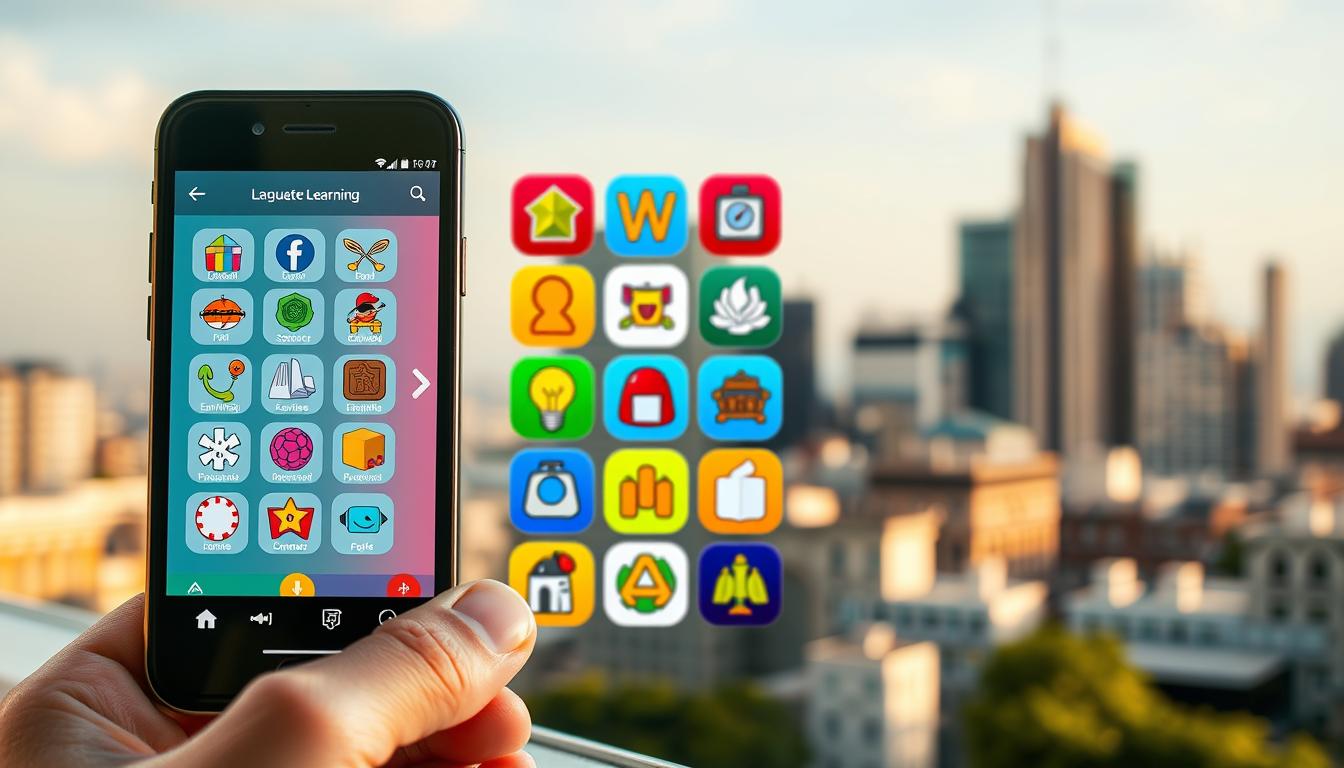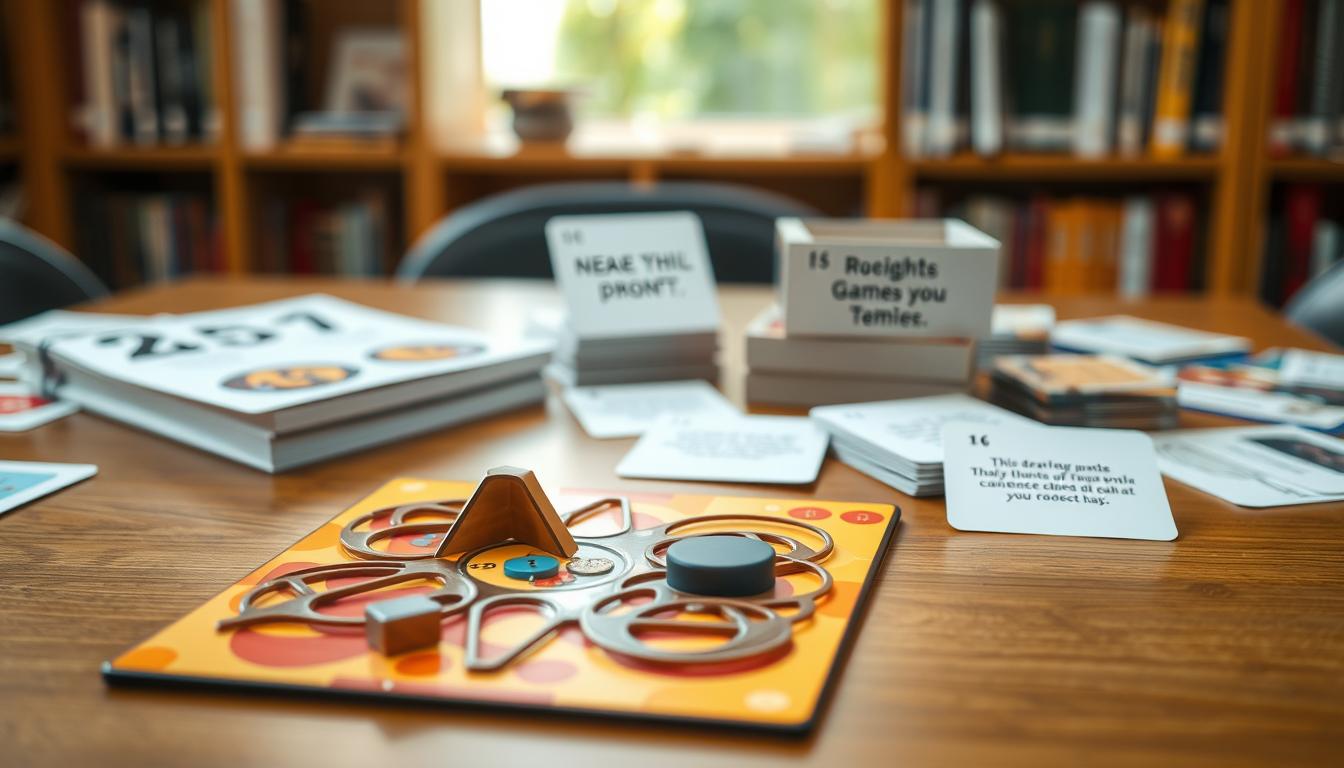Apps that combine language learning with cognitive games designed for adults
Ever thought about improving your brain while learning a new language? Language learning apps are changing how adults pick up a new language. They mix learning with fun games, making it both enjoyable and mentally stimulating.
We’ll look into how these apps are making learning a new language more fun and effective. They use games to boost your mental skills, making the journey more enjoyable.
Introduction to Language Learning Through Games
Language learning games are becoming a big hit in adult education. They make learning new languages fun and engaging. This approach boosts user interest, motivation, and helps keep new words and grammar fresh in their minds.
Old ways of learning languages often feel dull and repetitive. But, games in education change that. They let learners deal with real-life situations, practice using language in context, and get feedback right away. This shows how important it is to use modern tools in teaching.

The Importance of Cognitive Skills in Language Learning
Cognitive skills are key for learning a new language. They include memory, problem-solving, and being adaptable. These skills help a lot in the learning process.
A good memory helps keep vocabulary and grammar rules in mind. Problem-solving skills make it easier to handle language challenges. Being adaptable means changing learning strategies based on personal experiences and feedback.
When learners have strong cognitive skills, they get more out of new content. This leads to better learning opportunities. Students can try different ways to learn a language.
Improving cognitive skills can make learning a language faster. Games and activities that challenge the mind help. They make learners more agile and improve their language skills.
These methods help understand complex language elements. This leads to a deeper understanding of communication.
Popular Language Learning Apps with Mental Games
The world of language learning has changed a lot with new apps that mix fun with brain games. These apps make learning a language exciting and help improve your brain skills. Duolingo and Lumosity are two top apps that use games to help you learn.
Duolingo: A Fun and Addictive Approach
Duolingo is loved for its fun and interactive way of teaching. It breaks lessons into small, easy-to-do tasks. You earn points, level up, and get feedback right away. This makes learning a language fun and keeps you coming back for more.
Lumosity: A Cognitive Training Platform
Lumosity is a big deal for brain training with over 40 games. It helps improve your memory and problem-solving skills. These skills are great for learning new languages. Lumosity makes your brain sharp, helping you pick up new languages faster.
Gamification Elements in Language Learning Apps
Gamification is key in making language learning fun. Apps use rewards to keep users engaged. Points, badges, and leaderboards make learning a game, pushing users to do better.
Points, Rewards, and Leaderboards
Language apps give points and rewards for progress. Completing tasks earns points, unlocking cool rewards. Leaderboards show rankings, sparking friendly competition.
This makes learning exciting and keeps users coming back for more.
Interactive Exercises for Immediate Feedback
Getting feedback right away is vital for learning. Gamified apps offer interactive exercises for instant feedback. This lets users see their mistakes and fix them fast.
It makes learning fun and effective, helping users grow their language skills.
| Gamification Element | Benefits | Examples |
|---|---|---|
| Points | Encourages consistent practice and tracks progress | Duolingo’s point system |
| Rewards Systems | Enhances motivation via badges and achievements | Memrise’s reward milestones |
| Leaderboards | Encourages competition and social interaction | Busuu’s global rankings |
| Immediate Feedback | Enables swift correction of errors and boosts understanding | Rosetta Stone’s instant corrections |
How Duolingo Enhances Learning with Cognitive Play
Duolingo is a leader in language learning because of its use of cognitive play. This method keeps learners engaged and boosts their language skills. The app adjusts lessons to fit each user’s strengths and weaknesses.
This personal touch makes learning more fun and effective. It helps users stay on track and improve faster.
Duolingo also focuses on giving instant feedback. Learners get corrections and tips right away. This helps them understand better and correct mistakes quickly.
Research shows that 34 hours on Duolingo is like a full semester of language classes. This proves Duolingo’s cognitive play is a great way to learn a language. It mixes fun with serious learning.
Exploring Lumosity’s Unique Cognitive Challenges
Lumosity is known for its wide range of brain training activities. It offers over 40 different games to improve your thinking skills. These games are fun and help make your brain stronger.
40+ Activities Designed for Diverse Skills
Lumosity has games for memory, attention, and solving problems. Each game is made to improve a specific skill. This way, you can pick games that you enjoy and that help your brain.
Playing these games regularly can really show how your brain is getting better.
Fit Tests and Personalized Insights
When you start with Lumosity, you take a Fit Test. This test shows how well your brain is doing. Then, Lumosity creates a plan just for you, based on your strengths and areas to work on.
As you play more, you get feedback that helps you choose the right games. This makes learning more effective and fun.
Benefits of Using Language Learning Apps with Mental Games
Using mental games in language learning has many benefits. These apps make learning fun and improve your thinking skills. They offer a great way to learn and enjoy it at the same time.
Improving Memory and Problem-Solving Skills
Apps with mental games help a lot with memory. Studies show that playing games can make your brain work better. This means you can solve problems and remember words and rules more easily.
Continuous Learning and Retention
Game-based language tools keep you learning every day. They make learning fun and keep you coming back for more. This way, you learn and remember new things for a long time.
| Aspect | Traditional Methods | Language Learning Apps with Mental Games |
|---|---|---|
| Memory Retention | Often limited, relies on repetition | Enhanced through interactive gameplay |
| Engagement Levels | Generally lower | Higher, due to gamification |
| Problem-Solving Skills | Minimal improvement | Significant enhancement via challenges |
| Learning Rate | Slow progress | Accelerated by motivational elements |
| Long-Term Outcomes | Varied retention | Consistent improvement and retention |
The Role of Adaptivity in Language Learning Apps
Adaptivity is key in language learning apps. They use user data to make learning personal. By looking at how users interact and perform, these apps adjust the content to keep it right for each person.
These apps focus on each user’s path in learning a language. For example, if someone finds certain words or grammar hard, the app will make lessons about those topics. This way, learning stays fun and effective.
As users get better, the app gets smarter. It introduces new, harder stuff only when it’s the right time. This approach helps avoid getting stuck and keeps learning exciting. It makes learning a new language both fun and quick.
Language Learning Apps with Mental Games: A Review of the Best Options
Choosing the right app can make a big difference in learning a new language. The market has many top apps that mix mental games with learning. These apps aim to make learning fun and effective.
Duolingo is known for turning language learning into games. It has interactive exercises that keep users engaged. People say it helps them remember what they learn because of its scoring and leaderboards.
Lumosity is more about brain training but also has language learning activities. Its games focus on skills needed for language. Users like getting feedback and seeing how they improve over time.
In an exploratory table, we can outline key features of these popular apps for a clearer comparison:
| App Name | Primary Features | Learning Focus | User Experience Rating |
|---|---|---|---|
| Duolingo | Gamified lessons, Leaderboards | Language vocabulary and grammar | 4.8/5 |
| Lumosity | Cognitive challenges, Personalized feedback | Cognitive skills relevant to language | 4.6/5 |
App reviews show a trend towards using cognitive games in learning. By choosing the right app, users can learn in a way that suits them. These tools not only teach languages but also improve brain skills, making learning fun.
Understanding Subscription Models for Cognitive Apps
Looking into subscription models of cognitive learning apps gives us insights. Lumosity, a well-known app, has different pricing plans for everyone. This helps users choose the best option for them.
Lumosity Premium Pricing and Features
Lumosity offers several subscription plans to meet different needs. Here’s a look at their monthly and yearly costs:
| Subscription Type | Monthly Cost | Yearly Cost | Premium Features |
|---|---|---|---|
| Monthly Subscription | $11.99 | N/A | Access to all games, basic progress tracking |
| Yearly Subscription | N/A | $59.99 | Access to all games, in-depth progress tracking, personalized training recommendations |
The premium features give users a better look at their brain skills. The yearly plan is great for those serious about improving their brain power.
User Experiences and Testimonials
Language learning apps like Duolingo have become very popular. They offer an engaging way to learn new languages. Many users share how these apps have changed their lives.
The apps make learning a language fun and less scary. People say they feel more confident and skilled. They talk about how sticking with it pays off.
Success Stories with Duolingo
Many success stories highlight Duolingo’s effectiveness. Users love how it makes learning fun. They say it boosts their vocabulary and speaking skills.
People from all walks of life use Duolingo. It helps professionals and travelers alike. These stories prove Duolingo’s impact in different areas of life.
Are Language Learning Apps Worth It? Pros and Cons
Language learning apps with mental games have both good and bad sides. They offer many benefits and drawbacks. One big plus is how easy they make learning languages. You can practice anywhere, anytime.
People love the fun parts of these apps. The games make learning fun and keep you interested. This helps you remember new words better.
But, there are downsides too. Some worry about the cost of these apps. It might stop them from using all the app’s features. Also, how well you do depends a lot on your own effort.
Users say these apps are great as extra help, but not the only thing. Without regular study, you might not get as good as you want. So, it’s important to think about both the good and bad points before choosing.
Language Learning Apps with Mental Games: Future Trends
The future of learning languages looks bright and exciting. This is thanks to the mix of mental games with new language tools. These changes will make learning languages more fun and effective.
Technology in education is getting better, especially with AI. AI helps make learning personal by adjusting to each learner’s pace. It also adds fun elements like games to keep learning interesting.
As tech gets better, we’ll see more ways to get feedback and connect with others. This will make learning languages a more complete experience. The mix of games and learning will keep learners excited and motivated.
| Trend | Description |
|---|---|
| AI Personalization | Utilizing artificial intelligence to tailor lessons based on learner performance. |
| Gamification Strategies | Incorporating game-like elements such as scoring and rewards to enhance engagement. |
| Interactive Learning Communities | Creating platforms where learners can connect and practice languages together. |
| Real-Time Feedback | Offering immediate responses to learners’ actions to aid in retention and understanding. |
Conclusion
In this summary, we looked at how cognitive games help adults learn new languages. These apps make it easier to remember words and grammar. They also improve critical thinking and problem-solving, key for language mastery.
Our final thoughts show how gamification is changing language learning for adults. It makes learning fun and engaging. With apps like Duolingo and Lumosity, everyone can find something that fits their learning style.
We suggest trying out apps that mix cognitive games with language learning. They make learning fun and rewarding. Start using these apps to boost your language skills and enjoy the journey.
FAQ
What are some popular language learning apps that integrate cognitive games?
Duolingo and Lumosity are top choices. Duolingo uses fun lessons and games. Lumosity boosts your brain skills to help learn languages.
How does gamification enhance language learning?
Gamification makes learning fun and keeps you motivated. It uses points, rewards, and games to help you remember better.
Why are cognitive skills important in language learning?
Skills like memory and problem-solving help you learn faster. They make it easier to understand and remember new words and phrases.
How does Duolingo utilize cognitive play?
Duolingo tailors lessons to fit your learning style. It makes learning a game. Studies show it’s as good as a semester of college courses.
What types of cognitive activities does Lumosity offer?
Lumosity has over 40 games for different skills. It starts with a test to see your strengths. Then, it offers training to improve your skills.
How does the adaptivity of language learning apps improve learning?
Apps adjust lessons based on how you’re doing. This makes sure you’re learning at the right pace and level.
What are the subscription models for cognitive learning apps?
Lumosity has monthly and yearly plans. The premium version gives deeper insights into your brain performance. It’s great for focused training.
What do users have to say about their experiences with Duolingo?
Duolingo users love how it makes learning fun. They say it helps them reach their language goals with regular practice.
What are some of the pros and cons of using language learning apps with mental games?
The good points are more fun and better memory. But, there are downsides like cost and needing to stay motivated.
What are the emerging trends in language learning apps?
New tech and personalized learning are changing apps. They’ll soon be even better at helping you learn languages through games.














